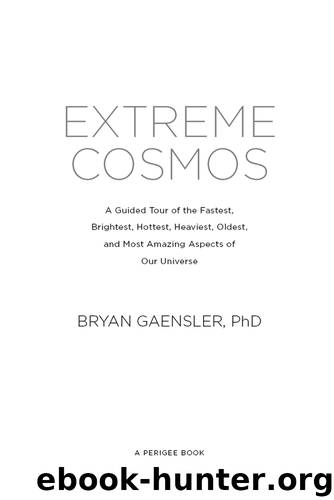Extreme Cosmos by Bryan Gaensler

Author:Bryan Gaensler [Gaensler, Bryan]
Language: eng
Format: epub
ISBN: 9781101587010
Publisher: Penguin Group US
Published: 2012-07-02T16:00:00+00:00
As big as they come
Although most of the stars in the sky are small and unimpressive red dwarfs, we have already seen in chapter 4 that it’s the rare, large stars that catch our attention. As I mentioned above, almost every bright naked-eye star in the sky is heavier than the Sun. For example, the brightest star in the sky, Sirius, has a mass almost exactly twice that of the Sun, while the second-brightest star, Canopus, has more than eight times the Sun’s mass. But even these big beasts are unremarkable by galactic standards.
Let’s start with the heaviest star we can see unaided. That title most likely belongs to Alnilam, the middle star in Orion’s Belt. Alnilam is not a binary star, but by comparing it with other stars with accurate mass measurements we can estimate that it weighs an astonishing 90,000 trillion trillion tons, some 40 times more than the Sun. Alnilam is also hundreds of thousands of times more luminous than the Sun, but is 1,300 light-years away. This is much more distant than almost all other naked-eye stars (Sirius is 8.6 light-years away; Canopus is about 300 light-years distant), so that instead of being overwhelmed by Alnilam’s brightness, we see it merely as the 30th brightest star in the sky.
This extreme level of stellar obesity is unusual, but it still does not come close to pushing the limit. Since more massive stars are increasingly hotter and brighter, one might expect that the heaviest stars in the Galaxy should be devastating in their brilliance, and easy to spot. However, finding the super heavyweights of the stellar community is extremely challenging. Not only do we expect these stars to be very rare, but we anticipate that they will also normally be especially well hidden.
The heaviest stars gobble their fuel extremely quickly, and so are extremely short-lived, lasting just a few million years from birth to death. This means that they have no time to drift around the Galaxy during their lives, and will inevitably be found very close to their places of birth. These stellar nurseries are complicated, messy places, filled with many bright young stars, glowing gas, and dark nebulas (see chapter 2). If we are hunting for the heaviest stars, such agglomerations are the obvious places to look. However, with all this other clutter obscuring our view, finding the most massive stars is not simple. First, we have to pick which of the hundreds of stars in the region we think might be the heaviest, and then we have to accurately measure its mass despite all the other stars and gas in the way. Finding ultra-heavy stars is thus a painstaking process, requiring special effort.
To narrow down the search for the most massive star in the Milky Way, I need to introduce you to an extremely rare class of objects known as “Wolf-Rayet stars.” Named after the French astronomers Charles Wolf and Georges Rayet (who discovered these remarkable stars in 1867), Wolf-Rayet stars are very hot, very luminous, and very heavy.
Download
This site does not store any files on its server. We only index and link to content provided by other sites. Please contact the content providers to delete copyright contents if any and email us, we'll remove relevant links or contents immediately.
The Complete Stick Figure Physics Tutorials by Allen Sarah(7307)
Secrets of Antigravity Propulsion: Tesla, UFOs, and Classified Aerospace Technology by Ph.D. Paul A. Laviolette(5309)
Thing Explainer by Randall Munroe(3875)
The River of Consciousness by Oliver Sacks(3535)
The Order of Time by Carlo Rovelli(3144)
How To by Randall Munroe(3031)
A Brief History of Time by Stephen Hawking(2959)
I Live in the Future & Here's How It Works by Nick Bilton(2934)
The Great Unknown by Marcus du Sautoy(2645)
What If?: Serious Scientific Answers to Absurd Hypothetical Questions by Randall Munroe(2637)
Midnight in Chernobyl by Adam Higginbotham(2483)
Blockchain: Ultimate Step By Step Guide To Understanding Blockchain Technology, Bitcoin Creation, and the future of Money (Novice to Expert) by Keizer Söze(2444)
Networks: An Introduction by Newman Mark(2358)
The Meaning of it All by Richard Feynman(2298)
Easy Electronics by Charles Platt(2281)
The Tao of Physics by Fritjof Capra(2227)
Midnight in Chernobyl: The Untold Story of the World's Greatest Nuclear Disaster by Adam Higginbotham(2176)
When by Daniel H Pink(2082)
Introducing Relativity by Bruce Bassett(2076)
